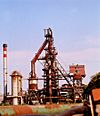A blast furnace is a huge oven used to make iron from iron ore. This list tells you about old blast furnaces that are no longer used but have been saved so people can visit them. They are often part of a park, museum, or a place open to the public.
For a long time, when a blast furnace stopped working, it was usually torn down. Sometimes a new, better one was built in its place, or the whole area was cleared for something else. But in recent years, many countries have realized that these old furnaces are important parts of their industrial history. They show us how things were made in the past.
One of the first blast furnaces saved from being torn down is in Starachowice, Poland. It stopped working in 1968. Then came the last blast furnace of Yahata Steel Works in Yahatahigashi-ku, Kitakyūshū, Japan, which closed in 1972. After that, the "Carrie Furnaces" in Homestead, Pennsylvania, United States, were saved in 1978. A blast furnace in Neunkirchen, Germany, which closed in 1982, was the first one worldwide to be not just saved, but also fixed up specifically to be preserved.
Modern blast furnaces from the 20th century were huge and made a lot of iron. How they are preserved can be different. Some are kept almost exactly as they were, while others are changed a bit or used for new things. It's common to see them lit up with colorful lights at night!
Historic Blast Furnaces from Before Mass Production
These are older blast furnaces, built before the huge industrial ones. They often used charcoal as fuel.
Australia's Old Ironworks
| City and State |
Name of Location |
What's There Now |
Photo |
Official Website |
| Lal Lal, Victoria |
Lal Lal Iron Company |
This furnace was built in 1880 and worked until 1884. It's now part of a historic area. |
 |
Parks Victoria |
| Beaconsfield, Tasmania |
Ilfracombe Iron Company |
Built in 1873, this furnace was abandoned in 1874. Its ruins are on private land. |
 |
None |
| Bookham, New South Wales |
Bogolong iron mine and blast furnace |
This furnace was built in 1873–1874 and only worked for a short time in 1874. Its ruins are on private land but you can see parts of it from a public road. |
 |
NSW Heritage Database |
Austria's Preserved Furnaces
| City |
Name of Location |
What's There Now |
Photo |
Official Website |
| Thomatal, Tamsweg, Salzburg |
Bergbaumuseum Hochofen Bundschuh |
This blast furnace, built in 1867, stopped working in 1903 and became a museum in 1984. |
|
[1] |
Brazil's Iron History
| City |
Name of Location |
What's There Now |
Photo |
Official Website |
| Ipanema, Iperó, Sao Paulo |
Fábrica de Ferro de São João do Ipanema |
Three blast furnaces are here. Two were built in 1817 and one in 1884. They stopped working in 1926 and opened to the public in 1994, now part of a national forest. |
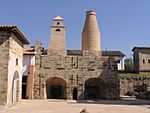 |
|
Finland's Industrial Past
| City |
Name of Location |
What's There Now |
Photo |
Official Website |
| Karkkila |
Högforsin ruukki |
This blast furnace was built between 1820 and 1822 and stopped working in 1916. |
|
Museovirasto |
Germany's Iron Landmarks
| City |
Name of Location |
What's There Now |
Photo |
Official Website |
| Völklingen, Saarland |
The Völklingen Ironworks (Völklinger Hütte) |
This was a major ironworks with 6 blast furnaces. It was the only one to survive World War II without serious damage. In 1994, UNESCO named it a World Heritage Site. Today, it's a museum where you can learn about making iron. You can tour the production areas and see huge machines. |
 |
Völklinger Hütte |
| Between Grünebach and Alsdorf, Rhineland-Palatinate |
Neugrünebacher Hütte |
This historic blast furnace stopped working in 1963 and was protected as a monument in 1983. |
|
|
| Wenden, Sauerland, North Rhine-Westphalia |
Wendener Hütte |
This furnace stopped working in 1866. The building that holds the blast furnace is now a museum. |
 |
[2] |
| Balve, Sauerland, North Rhine-Westphalia |
Luisenhütte Wocklum |
This furnace stopped working in 1865. The building with the oldest completely preserved blast furnace in Germany became a protected monument in 1950. It reopened as a museum in 2006 after a big renovation. |
 |
|
| Bockenem-Bornum, Ambergau, Lower Saxony |
Wilhelmshütte |
This historic blast furnace, built in 1783, stopped working in 1966 and opened to the public in 1982 as a museum. |
|
|
Poland's Industrial Heritage
| City |
Name of Location |
What's There Now |
Photo |
Official Website |
| Chlewiska, Gmina Chlewiska, Szydłowiec County, Mazowieckie Voivodeship |
Iron Works in Chlewiska |
Built between 1882 and 1892, this ironworks stopped in 1940. It's now part of the Museum of Technology and open to visitors. |
|
|
| Kuźniaki, Gmina Strawczyn, Kielce County, Świętokrzyskie Voivodeship |
Metallurgical Furnace in Kuźniaki |
This furnace stopped working in 1897. The building that holds the blast furnace is now a historical monument and open to visitors. |
 |
|
| Samsonów, Gmina Zagnańsk, Kielce County, Świętokrzyskie Voivodeship |
Huta Józef |
This furnace stopped working in 1866. It was declared a historical monument in 1967 and opened to visitors in 1983. |
 |
|
Romania's Blast Furnaces
| City |
Name of Location |
What's There Now |
Photo |
Official Website |
| Govăjdia, Hunedoara County |
Blast Furnace in Govăjdia |
Built between 1806 and 1810, this furnace stopped working in 1924. It's famous for providing iron for the Eiffel Tower in Paris! It became a historical monument in 2000 and opened to visitors in 2007. |
 |
|
Slovakia's Old Furnaces
| County |
Name of Location |
What's There Now |
Photo |
Official Website |
| Near village Osrblie |
Tri vody (Three Waters) |
This was the oldest blast furnace in the old Kingdom of Hungary, built in 1795. A fire destroyed the factory in 1882, but the furnace casing is still preserved. |
|
[3] |
| Spiš |
Jakubany |
This blast furnace, built in 1776, is still in fair condition. It was part of a larger ironworks that closed in the 1860s. |
[4] |
|
| Spiš |
Krompachy |
The first blast furnace here was built in 1831. The plant was torn down after 1921, and a copper factory was built in its place. |
[5] |
|
| Gemer-Malohont |
Nižná Slaná |
This blast furnace worked between 1867 and 1907. It was owned by the Andrássy family. |
[6] |
|
| Orava |
Podbiel |
This blast furnace, part of the "Františkova Huta" ironworks, worked from 1836 to 1862. |
[7] |
|
| Gemer-Malohont |
Sirk, local part Červeňany |
This blast furnace worked between 1871 and 1903. Its main shaft was renovated in the 1970s. |
[8] |
|
| Gemer-Malohont |
Vlachovo |
This blast furnace worked from 1843 to 1907. Its shaft still exists today. |
[9] |
|
| Zemplín |
Zemplínske Hámre |
This blast furnace was built in 1815 and stopped working in 1873. Only the bottom part (crucible) of the original furnace can be seen now. A model of the furnace was built in 2015. |
[10] |
|
Ukraine's Historic Furnaces
| County |
Name of Location |
What's There Now |
Photo |
Official Website |
| Between villages of Yasen’ and Hryn’kiw, Kalush Raion, Ivano-Frankivsk Oblast. |
|
A charcoal blast furnace built in 1810. It worked until 1818. It might be the oldest historical blast furnace in Ukraine. |
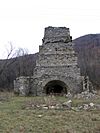 |
|
| Village Maidan, Drohobych Raion, Lviv oblast |
|
A charcoal blast furnace built in 1814, it was 9.48 meters tall. |
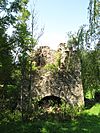 |
[11] |
| Village Mihove, Vyzhnytsia Raion, Chernivtsi Oblast |
|
A charcoal blast furnace built in 1835, it was 14 meters tall. |
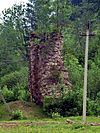 |
|
United Kingdom's Iron Heritage
England's Furnaces
| County |
Name of Location |
What's There Now |
Photo |
Official Website |
| Cumbria |
Newland Furnace |
A charcoal blast furnace built in 1747. It worked until 1891. You can visit it on special open days or by appointment. |
 |
[12] |
| Cumbria |
Backbarrow Furnace |
Built as a charcoal blast furnace in 1711. It worked until 1966. It's on private land but you can see it from the road. |
 |
|
| Broughton-in-Furness, Cumbria |
Duddon furnace |
A charcoal blast furnace that worked from 1736 to 1867. It's managed by the Cumbria Tourist Board. |
 |
[13] |
| Telford, Shropshire |
Blists Hill |
The remains of three 19th-century blast furnaces are here. They were built in 1832 and worked until 1912. They are part of the Ironbridge Gorge Museum Trust. |
 |
IGMT |
| Coalbrookdale |
Originally a charcoal furnace, this old blast furnace was used by Abraham Darby I in 1709 to make iron using coke. This was a big step in iron production! It's now part of the Ironbridge Gorge Museum Trust's Museum of Iron. |
 |
IGMT |
| Madeley Wood or Bedlam |
Two blast furnaces stand by the River Severn. They were built in 1756 and worked until 1912. They used water wheels powered by steam engines. The site is owned by Ironbridge Gorge Museum Trust. |
 |
|
| The Forest of Dean, Gloucestershire |
Darkhill Ironworks |
These are very important remains related to how iron and steel were developed. Built in 1818, this site saw many important discoveries in making iron and steel. |
 |
|
| Whitecliff Ironworks |
These are the remains of a furnace that used coke, built in 1798. It's part of the history of iron making in the Forest of Dean. |
 |
|
| Parkend Ironworks |
This was a coke-fired furnace built in 1799. Most of it was torn down, but the engine house survived and is one of the best preserved in the UK. |
 |
|
Scotland's Furnaces
| County |
Name of Location |
What's There Now |
Photo |
Official Website |
| Argyllshire |
Bonawe or Lorn Furnace |
A charcoal furnace that worked from 1753 to 1876. |
 |
Historic Iron Furnace |
| Argyllshire |
Argyll or Craleckan or Goatfield Furnace, Furnace |
A charcoal furnace that worked from 1755 to 1812. The furnace building is by the road in the village of Furnace. You can see it from the road, but can't go inside. |
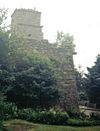 |
|
Wales's Iron Sites
| County |
Name of Location |
What's There Now |
Photo |
Official Website |
| Ceredigion |
Dyfi Furnace |
A charcoal blast furnace near the west coast of Wales, built in 1755. It worked until 1805 and is now preserved by Cadw. |
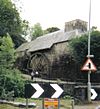 |
|
| Monmouthshire |
Tintern Furnace |
This is an excavated site of a charcoal blast furnace. It's now a tourist attraction and was part of a group of ironworks in the valley. |
|
|
| Torfaen |
Blaenavon Ironworks |
An ironworks that used coke, working from 1789 to 1903. It's now preserved by Cadw and is a World Heritage Site. |
 |
|
| Neath Port Talbot |
Neath Abbey Ironworks |
Remains of two furnaces built in 1792. |
|
|
United States's Early Furnaces
| City and State |
Name of Location |
What's There Now |
Photo |
Official Website |
| Cartersville, Georgia |
Cooper Iron Works |
Built by Mark Anthony Cooper in 1847. |
|
Cooper's Furnace |
| Clifton Forge, Alleghany County, Virginia |
Clifton Furnace |
This site started working around 1825. The charcoal furnace you see now was built in 1846 and worked until 1854. It was renovated in 1874 but closed for good in 1877. |
 |
[14] |
| Saugus, Massachusetts |
Saugus Ironworks |
An early ironworks from the 1600s. It was dug up and rebuilt in the 1950s. It's now a National Historic Site managed by the National Park Service. |
 |
NPS |
| Fayette, Michigan |
Jackson Iron Company |
A charcoal blast furnace that worked from 1867 to 1891. It's now part of Fayette Historic State Park. |
 |
Fayette Historic State Park |
| Cornwall, Pennsylvania |
Cornwall Iron Furnace |
A charcoal blast furnace that worked from 1742 to 1883. It has been preserved since 1932. |
 |
Cornwall Iron Furnace |
| Elverson, Pennsylvania |
Hopewell Furnace |
A charcoal-fired furnace that worked from around 1771 to 1883. It's a National Historic Site where you can see how iron was made. They sometimes have demonstrations. |
 |
Hopewell Furnace NHS |
| Robeson Twp., Pennsylvania |
Joanna Furnace |
This furnace worked from 1791 to 1898. It used charcoal and water power, then steam power. They have demonstrations of hand casting and other old machines. |
|
www.haycreek.org |
| Rosiclare, Illinois |
Illinois Iron Furnace |
This furnace worked from 1838-1861 and again from 1868 to 1883. It was used to melt iron ore found nearby. The iron was then sent down the Ohio River. The area is now a picnic spot with information about the furnace. |
|
Shawnee National Forest web site |
Preserved Modern Blast Furnaces Around the World
These are the bigger, more industrial blast furnaces, mostly from the 20th century. They have metal frames, used hot air from special "Cowper stoves," and were part of huge factories with many furnaces working together. Raw materials came in by train, and the freshly made iron was carried away in special buckets called ladles.
Often, when these big factories were turned into museums, some parts were removed to make them easier to take care of. The idea was to keep just one or two blast furnaces and their important parts (like the Cowper stoves and buildings) so visitors could understand how they worked.
The very first modern blast furnace that was saved instead of being torn down is in Starachowice, Poland. It stopped working way back in 1968.
Czech Republic's Industrial Park
| City |
Name of Location |
What's There Now |
Photo |
Official Website |
| Ostrava-Vítkovice, Moravian-Silesian Region |
Vítkovice Area |
This site used to be the Vítkovice Iron and Steel Works, which closed in 1998. It's now an industrial heritage site being rebuilt for new uses, but you can visit it by booking ahead. Three blast furnaces are saved, along with their Cowper stoves and buildings. At night, colorful lights shine on the whole factory. They are trying to get it recognized as a UNESCO World Heritage Site. |
 |
[15] |
France's Preserved Furnace
| City |
Name of Location |
What's There Now |
Photo |
Official Website |
| Uckange, Moselle, Lorraine |
Parc du Haut-Fourneau |
This furnace stopped working in 1991 and opened to the public in 2007 as part of a park. One blast furnace (U4) is preserved, including its Cowper stoves. Colorful lights light up the factory at night. |
 |
[16] |
Germany's Industrial Parks
| City and Region |
Name of Location |
What's There Now |
Photo |
Official Website |
| Dortmund, Ruhr, North Rhine-Westphalia |
Phoenix-West |
This area is becoming a modern technology center. Some old ironworks buildings will be used, and others will become a museum. One blast furnace is saved, and another is partly taken apart, but its frame and Cowper stoves remain. You can visit on guided tours along a "Skywalk." Colorful lights sometimes light up the plant. |
 |
[17] |
| Duisburg, Ruhr, North Rhine-Westphalia |
Landschaftspark Duisburg-Nord |
This old ironworks site, which closed in 1985, is now a public park that uses the old buildings with few changes. Three complete blast furnaces are preserved. One building is now a hall for events and a summer movie theater. Another building is a climbing garden for kids. You can go up blast furnace 5 for amazing views. Colorful lights light up the whole park at night on weekends. |
 |
[18] |
| Hattingen, Ruhr, North Rhine-Westphalia |
Henrichshütte |
This ironworks closed in 1987 and became a museum in 2000. One complete blast furnace is preserved. It's painted to prevent rust. This blast furnace is a main part of the museum, with information and films. You can go up it for views using an elevator. Colorful lights light it up at night. |
 |
[19] |
| Neunkirchen, Saarland |
Altes Hüttenareal Neunkirchen |
The remains of this ironworks, which closed in 1982, are now part of a public park. New buildings like pubs and a movie theater are built around the old structures. Two blast furnaces are preserved and painted to prevent rust. You can visit blast furnace 6 on guided tours. Colorful lights light up the whole area at night. |
 |
[20] |
| Sulzbach-Rosenberg, Bavaria |
Maxhütte |
This steel mill closed in 2002. Many parts are being torn down, but a small area with the blast furnace is being saved. It's not open to the public yet. One blast furnace remains. |
 |
|
| Völklingen, Saarland |
Völklingen Ironworks |
This ironworks closed in 1986 and became a museum. It was named a UNESCO World Heritage Site in 1994. Six blast furnaces are preserved. You can go up them for views. Colorful lights light up the whole factory at night. |
 |
[21] |
Japan's Steel History
| City and Prefecture |
Name of Location |
What's There Now |
Photo |
Official Website |
| Yahatahigashi-ku, Kitakyūshū, Fukuoka Prefecture, Kyūshū Island |
Higashida Blast Furnace Memorial Square |
This site used to be Yahata Steel Works, which closed in 1972. It's now a museum that opened in 1997. You can even go inside the blast furnace! One blast furnace is preserved and painted to prevent rust. Lights illuminate the site at night. |
 |
[22] |
Luxembourg's Industrial Site
| City |
Name of Location |
What's There Now |
Photo |
Official Website |
| Esch-sur-Alzette |
Esch Belval |
This site closed in 1997 and is being turned into a new area for many uses. Two blast furnaces have been preserved. |
 |
[23] |
Mexico's Park and Museum
| City and Country |
Name of Location |
What's There Now |
Photo |
Official Website |
| Monterrey |
Fundidora Park (Parque Fundidora) |
This steel mill closed in 1986 and became a public park in 1988. One blast furnace is a museum. Two blast furnaces are preserved. Blast furnace 3 is a museum where you can go up for views using an elevator. The whole factory is lit up at night. They are trying to get blast furnaces 1 and 3 recognized as UNESCO World Heritage Sites. |
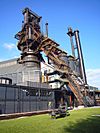 |
[24] |
Poland's Ecomuseum
| City and Province |
Name of Location |
What's There Now |
Photo |
Official Website |
| Starachowice, Świętokrzyskie Voivodeship |
Museum of Nature and Technology Ekomuseum Jana Pazdura |
This furnace closed in 1968 and opened as a museum in 2000. One blast furnace is preserved. |
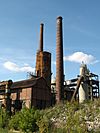 |
[25] |
Romania's Active Steel Mill
| City |
Name of Location |
What's There Now |
Photo |
Official Website |
| Reșița, Caraș-Severin County |
Inside TMK Reșița |
Blast furnace number 2, built between 1959 and 1962, closed in 1991. It's now a historical monument. You can't visit it because it's inside an active steel mill, but you can see it well from outside. |
 |
|
Russian Federation's Museums
| City and Province |
Name of Location |
What's There Now |
Photo |
Official Website |
| Nizhny Tagil, Sverdlovsk Oblast |
Nizhny Tagil Museum-Reserve of Mining and Metallurgy of the Middle Urals |
This steel mill closed in 1987 and became part of a museum in 1992. Two blast furnaces are preserved. |
 |
[26] |
| Polevskoy, Sverdlovsk Oblast |
Museum Complex "Seversky Blast Furnace" |
This blast furnace was built in 1860, rebuilt in 1896, and turned into a museum in the 1980s. |
[27] |
[28] |
Spain's Preserved Furnaces
United States's Industrial Landmarks
| City and State |
Name of Location |
What's There Now |
Photo |
Official Website |
| Bethlehem, Pennsylvania |
Bethlehem Steel |
This huge steel plant closed in 1995. Now, a casino hotel is on the site. Five blast furnaces are still standing. They were meant to be part of a museum, but plans changed. |
 |
[30] |
| Rankin, Pennsylvania |
Carrie Furnace |
These two blast furnaces, which closed in 1978, are preserved. You can visit them on guided tours. There are plans for them to be part of a national park. |
 |
|
| Birmingham, Alabama |
Sloss Furnaces |
This blast furnace made iron from 1882 to 1971. Two blast furnaces are preserved. It was named a National Historic Landmark in 1981. Today, it's a museum about industry and also hosts concerts and festivals. |
 |
[31] |











































